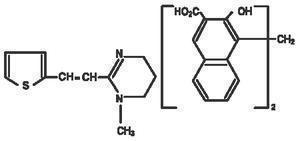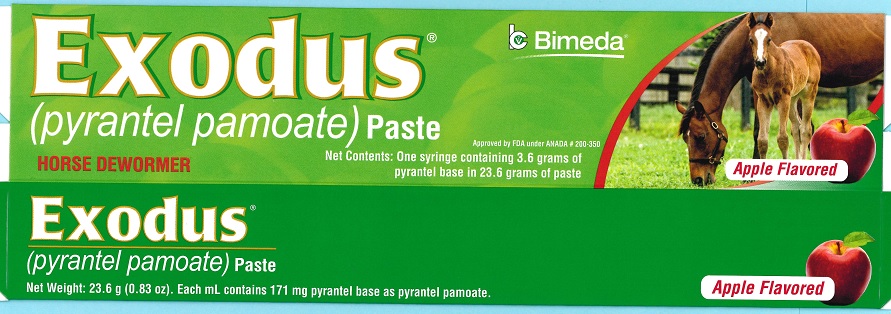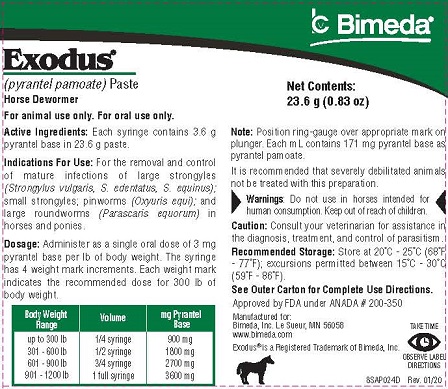Animal NDC 61133-0141-1 Exodus
Pyrantel Pamoate
Animal Product Information
Exodus Images
Exodus Animal Product Labeling Information
The product labeling information includes all published material associated to a drug. Product labeling documents include information like generic names, active ingredients, ingredient strength dosage, routes of administration, appearance, usage, warnings, inactive ingredients, etc.
Table of Contents
Description
Read Entire Carton Carefully Before Using This Product
DESCRIPTION:
Exodus® (pyrantel pamoate) Paste is a pale yellow to buff paste containing 43.9% w/w pyrantel pamoate in an inert vehicle. Each syringe contains 3.6 grams pyrantel base in 23.6 grams paste. Each mL contains 171 mg pyrantel base as pyrantel pamoate.
Components
COMPOSITION:
Pyrantel pamoate is a compound belonging to a family classified chemically as tetrahydropyrimidines. It is a yellow, water-insoluble crystalline salt of the tetrahydropyrimidine base and pamoic acid containing 34.7% base activity. The chemical structure and name are given above.
CHEMICAL STRUCTURE:
Chemical name: (E)-1,4,5,6-tetrahydro-1-methyl-2-[2-(2-thienyl)-vinyl]-pyrimidine 4,4' methylenebis [3-hydroxy-2-naptholate] (1:1)
Indications & Usage
INDICATIONS FOR USE:
For the removal and control of mature infections of large strongyles (Strongylus vulgaris, S. edentatus, S. equinus); small strongyles; pinworms (Oxyuris equi); and large roundworms (Parascaris equorum) in horses and ponies.
Consult your veterinarian for assistance in the diagnosis, treatment, and control of parasitism.
Dosage & Administration
DOSAGE AND TREATMENT:
Exodus® (pyrantel pamoate) Paste is to be administered as a single oral dose of 3 mg pyrantel base per lb of body weight. The syringe has 4 weight mark increments. Each weight mark indicates the recommended dose for 300 lb of body weight.
DOSAGE
Body Weight Range | Volume | mg Pyrantel Base |
up to 300 lb | ¼ syringe | 900 mg |
301 – 600 lb | ½ syringe | 1800 mg |
601 - 900 lb | ¾ syringe | 2700 mg |
901 - 1200 lb | 1 full syringe | 3600 mg |
Note: Position ring-gauge over appropriate mark on plunger. Each mL contains 171 mg of pyrantel base as pyrantel pamoate.
Do not underdose. Ensure each animal receives a complete dose based on a current body weight. Underdosing may result in ineffective treatment, and encourage the development of parasite resistance.
For maximum control of parasitism, it is recommended that foals (2-8 months of age) be dosed every 4 weeks. To minimize the potential source of infection that the mare may pose to the foal, the mare should be treated 1 month prior to anticipated foaling date by retreatment 10 days to 2 weeks after birth of foal. Horses and ponies over 8 months of age should be routinely dosed every 6 weeks.
It is recommended that severely debilitated animals not be treated with this preparation.
ADMINISTRATION:
After removing the cap, the paste should be deposited on the dorsum of the tongue. Introduce the nozzle end of the syringe at the corner of the mouth. Direct the syringe backwards and depress the plunger to deposit the paste onto the tongue. Given in this manner, it is unlikely that rejection of the paste will occur. Raising the horse’s head sometimes assists in the swallowing process. When only part of the paste has been used, replace the cap on the syringe nozzle.
EFFICACY:
Critical (worm count) studies in horses demonstrated that pyrantel pamoate administered at the recommended dosage was efficacious against mature infections of Strongylus vulgaris (>90%), S. edentatus (69%), S. equinus (>90%), Oxyuris equi (81%), Parascaris equorum (>90%), and small strongyles (>90%).
Warnings
WARNINGS
For oral animal use only. Do not use in horses intended for human consumption.
HUMAN WARNINGS:
Keep out of the reach of children.
It is recommended that severely debilitated animals not be treated with this preparation.
OTHER WARNINGS: Parasite resistance may develop to any dewormer, and has been reported for most classes of dewormers. Treatment with a dewormer used in conjunction with parasite management practices appropriate to the geographic area and the animal(s) to be treated may slow the development of parasite resistance. Fecal examinations or other diagnostic tests and parasite management history should be used to determine if the product is appropriate for the herd prior to the use of any dewormer. Following the use of any dewormer, effectiveness of treatment should be monitored (for example, with the use of a fecal egg count reduction test or another appropriate method). A decrease in a drug's effectiveness over time as calculated by fecal egg count reduction tests may indicate the development of resistance to the dewormer administered. Your parasite management plan should be adjusted accordingly based on regular monitoring.
To report suspected adverse drug events, for technical assistance or to obtain a copy of the Safety Data Sheet (SDS), contact Bimeda, Inc. at 1-888-524-6332. For additional information about adverse drug experience reporting for animal drugs, contact FDA at 1-888-FDA-VETS or online at www.fda.gov/reportanimalae.
Storage And Handling
RECOMMENDED STORAGE: Store at 20°C-25°C (68°F-77°F); excursions permitted between 15°C-30°C (59°F-86°F).
Other
Approved by FDA under ANADA # 200-350
Exodus®
(pyrantel pamoate) Paste
Horse Dewormer
Net Wt. 23.6 g
* The information on this page is for an ANIMAL PRODUCT, please review the complete disclaimer below.



